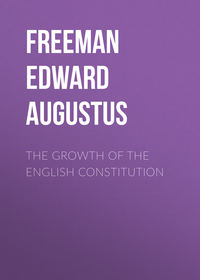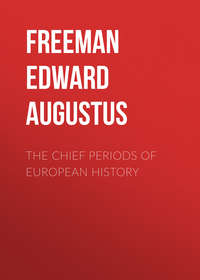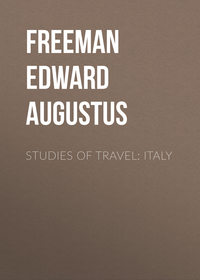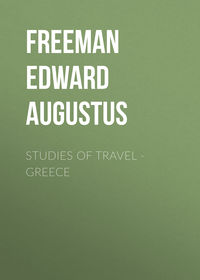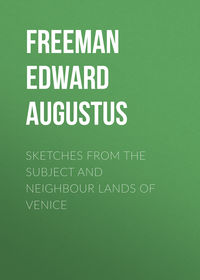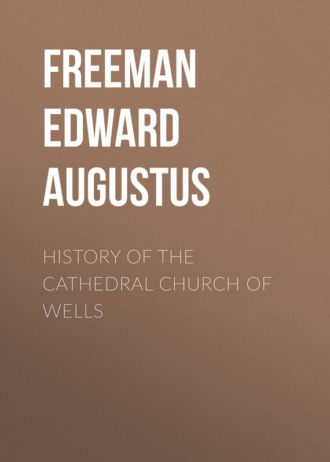 полная версия
полная версияHistory of the Cathedral Church of Wells
9
Ceawlin conquered to the Axe in 577; Cenwealh to the Parret in 658; Ine, as we see, as far as Taunton. On Ceawlin see Dr. Guest in the Archæological Journal, xix. 193.
10
That is, the modern shires of Monmouth and Glamorgan.
11
This is shown in various passages of the Laws of Ine. See Thorpe's Laws and Institutes, i. 119, 131, 147, 149.
12
See the whole history of the early church of Glastonbury in the first chapter of Professor Willis' Architectural History of Glastonbury Abbey.
13
See Willis' Architectural History of Canterbury, p. 20; ditto Winchester, p. 34.
14
It is not said in so many words that the church of Dunstan was of stone, but it is plain that it was so, both because the "lignea basilica" or wooden church is distinguished from it, and because Osbern the biographer of Dunstan (Anglia Sacra, ii. 100) speaks of him as laying the foundations, which could hardly be said of a wooden church.
15
See the account of the Canons of Waltham in the book De Inventione, and those of Rheims in Richer, iii. 24.
16
I have discussed this in full in my History of the Norman Conquest, ii. 571, Ed. 2.
17
When a Bishop is to be elected by the Chapter, two quite distinct documents are sent; there is first the congé d'élire, which recognizes the undoubted right of the Chapter to elect and gives them full leave to elect, only with a little good advice as to the sort of person to be chosen. With this, as a kind of after-thought, comes the letter missive or letter recommendatory, recommending a particular person for election.
18
The names of the early Bishops, of whom but little is recorded, will be found in the Canon of Wells, Anglia Sacra, i. 556, and Godwin's Catalogue of English Bishops, 290.
19
He was "natione Saxo," says his successor Gisa in the Historiola de Primordiis Episcopatûs Somersetensis. See Norman Conquest, ii. 583.
20
See Godwin, p. 291.
21
Anglia Sacra, i. 559.
22
See Historiola, 15-18; Mr. J. R. Green in the Transactions of the Somersetshire Archæological and Natural History Society, 1863-4, p. 148; and Norman Conquest, ii. 674.
23
For examples see Norman Conquest, ii. 549.
24
See the writ, the only writ of Harold's which is preserved, in Kemble's Codex Diplomaticus, iv. 305.
25
After mentioning Harold's promise, Gisa (Historiola, p. 18) adds, "præoccupante autem illum judicio divinæ ultionis," and goes on to speak of Harold's two battles and his death.
26
Historiola, p. 19, "publice vivere et inhoneste mendicare necessariorum inopia antea coegerat."
27
For the story of Hermann, see Norman Conquest, ii. 401.
28
On these places see Historiola, pp. 18, 19. But it is as well to say that the well-known charter of Eadward to Gisa, printed in Cod. Dipl. iv. 162, is undoubtedly spurious, though it is useful as giving the names of places in the neighbourhood, in older, though not always their oldest, forms.
29
The rule of Chrodegang will be found at length in D'Achery's Spicilegium, i. 565; and see Norman Conquest, ii. 84.
30
This was about 969. Adalbero's changes are described at length by Richer, iii. 24, in Pertz's smaller collection.
31
See Norman Conquest, ii. 84.
32
In Domesday Book, pp. 89-89 b, the land of the canons is put under that of the Bishop; "Canonici Sancti Andreæ tenent de Episcopo." This is much the same with the Canons of Exeter in p. 101 b. In the Exon Domesday, (71)"Isaac præpositus Canonicorum Sancti Andreæ" is mentioned by name.
33
Historiola, 21: "Sepultus est in ecclesiâ quam rexerat, in hemicyclo [a semicircle or round arch] facto in pariete a parte aquilonali prope altare, sicut Duduco prædecessor ejus sepultus est a meridie juxta altare."
34
Will. Malms. Gest. Regg. iii. 300. "Pronunciatum est secundum dicta canonum ut episcopi transeuntes de villis constituerent sedes suas in urbibus diœcesium suarum." This was in 1072, but the change at Wells did not take place just yet.
In his other book, the Gesta Pontificum (144 b), he says that John "minoris gloriæ putans si in villâ resideret inglorius, transferre thronum in Bathoniam animo intendit."
35
William of Malmesbury, in the place last quoted, says, "Cessit enim Andreas Simoni fratri, frater major minori."
36
See the Chronicles under 577, and note 9.
37
The charters are given in Dugdale's Monasticon, ii. 66, 67. In the second charter of Henry the First he speaks of "Batha ubi frater meus Willielmus et ego constituimus et confirmavimus sedem episcopatûs totius Summersetæ, quæ olim erat apud villam quæ dicitur Wella." The grant of the town which is confirmed in this charter of Henry is made in a charter of William Rufus on the same page.
38
So says William of Malmesbury in the passage last quoted: "Aliquantum dure in monachos agebat, quod essent hebetes et ejus æstimatione barbari."
39
The Historiola mentions the destruction of Gisa's buildings, and the Canon of Wells adds (Anglia Sacra, i. 560), "Fundum in quo prius habitabant sibi et suis successoribus usurpavit, palatiumque suum episcopale ibidem construxit."
40
See Willis' Architectural History of Winchester, 34, 35.
41
Historiola, p. 22. "Canonici foras ejecti coacti sunt cum populo communiter vivere."
42
The story of Hildebert, John, and the Provostship is given both in the Historiola and by the Canon of Wells. Several letters discussing the matter appeared in the Gentleman's Magazine in the year 1864 in the numbers for February, July, August, September, October, November, and December, especially one by Mr. Stubbs in November.
That Hildebert was the brother of Bishop John appears from a charter of Bishop Robert (which I shall have to quote again) in the Monasticon, ii. 293, where Bishop John is called the uncle of Precentor Reginald.
43
This comes afterwards in the Historiola, p. 24.
44
The Canon (p. 560) says, "Licet ipse confractus senio inde pœniteret, tamen ædificia canonicorum destructa minime reparavit, nec fundum eis injuste ablatum restituit." But the Historiola seems to imply at least a purpose of restitution, as its words are, "Pœnitentiâ ductus de sacrilegio perpetrato, resipuit et pœnituit, et pœnitentiam suam scriptam reliquit. Johannes vero Archidiaconus terras quas pater suus obtinuerat per hæreditatem et præposituram canonicorum nihilominus sibi usurpavit."
45
The Charter is printed in the Monasticon, ii. 268.
46
The Historiola and the Canon both call Godfrey simply "Teutonicus;" but it appears from the Continuator of Florence of Worcester (ii. 78) and from the Annals of Waverley (Ann. Mon. ii. 219) that he was Chancellor to Queen Adeliza. We can hardly doubt that he was one of her countrymen from the Netherlands.
47
This account of him is given both by the Historiola and by the Canon (Angl. Sacr. i. 561), who gives as a reason for his mission to Glastonbury, "eo quod non recte eorum aratra incedebant." His birth comes from the Continuator of Florence (ii. 95), who says that he was "Flandrensis genere, sed natus in partibus Angliæ."
48
Historiola, p. 25.
49
See the agreement in Wharton's note, Anglia Sacra, i. 561.
50
The Act is printed in the Monasticon, ii. 293.
51
Historiola, p. 24: "Ipse ecclesiam Beati Petri Apostoli de Bathoniâ magnis c[=u] expensis construi fecit."
52
Angl. Sacr. i. 561: "Complevit fabricam ecclesiæ Bathoniensis per Johannem Turonensem inchoatam." This seems to be confirmed by the words of John himself in the charter which I have already quoted (Monasticon, ii. 268), which is dated in 1116, and where he says that he sets aside the revenues of the city of Bath "ad perficiendum novum opus quod incepi."
53
Historiola, p. 24: "Capitulum quoque et claustrum, dormitorium et refectorium et infirmatorium, nihilominus ædificari fecit."
54
Historiola, p. 24. See above, p. 39.
55
The Historiola (p. 25) mentions only the Deanery and Precentorship as founded by Robert. "Decanatum in ecclesiâ constituit, et Decanum et Præcentorem primos ordinavit." But the Canon (p. 561) says, "Ordinavit etiam in ecclesiâ Wellensi Decanum et Subdecanum, Præcentorem et Succentorem, Thesaurarium et Cancellarium, quem vocavit Archiscolam in statutis ecclesiæ Wellensis, quæ ipse primus edidit omnium in eâdem." (Robert, the first to make the Chapter a distinct corporation, was naturally its first lawgiver.) He adds, "Tum Decanus, Subdecanus, etc. non habebant tunc temporis illa beneficia eis annexa, quæ eorum successores nunc habent in ecclesiâ antedictâ." But in the deed by which Bishop Robert founds the Deanery and divides the estates of the church into prebends (Monasticon, ii. 293), no dignitary is mentioned except the Dean and Precentor; and the church of Wookey, which afterwards belonged to the Sub-Dean, is specially mentioned as belonging to the Dean. This certainly looks as if Robert had founded the Deanery and Precentorship only. But, if they were not founded by Robert, they were founded by Jocelin, for the Canon says (564), "Jocelinus fundavit multas præbendas in ecclesiâ Wellensi de novo, dotavit etiam omnes dignitates, personatus, et officia dictæ ecclesiæ, in formâ adhuc durante."
The duties of the different officers of the church cannot be better described than they are by Bishop Godwin (p. 294): "He also it was that first constituted a Deane to be the President of the Chapter, and a Subdeane to supply his place in absence; a Chaunter to governe the quier, and a Subchaunter under him; a Chauncellour to instruct the yoonger sort of Cannons: and lastly a Treasurer to looke to the ornaments of the church." He adds, "The Subchauntership togither with the Provostship an. 1547. were taken away and suppressed by Act of Parliament, to patch up a Deanry, the lands and revenewes of the Deanry being devoured by sacrilegious cormorants."
56
He did what he did "consilio et auxilio illustris Regis Stephani et venerabilis Episcopi Henrici," says the Historiola, p. 24.
57
That is, in the churches of Bangor and Saint Asaph, and now in those of Saint David's and Llandaff. But, till the late changes, there were no Deans at Saint David's and Llandaff, beyond a vague tradition that the Bishop was Dean. At Saint David's the Precentor was President of the Chapter and at Llandaff the Archdeacon. The collegiate church of Southwell had no Dean or President under any title.
58
A sinecure is strictly an office sine curâ animarum, without cure of souls, not necessarily an office where there is nothing to do of any kind.
59
See the quotation in note 10.
60
I here alluded to the Theological College, where the offices of Principal and Vice-Principal are held by the Sub-Dean of the cathedral and another Canon, who are therefore really resident, but who are not admitted to any share in those rights and revenues which go to those nominal Residentiaries who stay away nine months in the year.
61
Beneficium is the word constantly used for a lay fief as well as for an ecclesiastical living. The most curious instance of this use will be found in the dispute between Pope Hadrian the Fourth and the Emperor Frederick Barbarossa. The Pope speaks of his coronation of the Emperor as a "beneficium" conferred on him. The German Bishops were very indignant, as if the Pope meant that the Empire was a fief of the Papacy. The Pope then explains that "beneficium" means both benefit and benefice. He thought that he had done the Emperor a benefit by crowning him, but he did not pretend to invest him with a benefice. See the History of Frederick by Otto (continued by Radevic) of Freisingen, ii. 15, 16, 22. Most likely the Pope used an ambiguous word on purpose.
62
Compare the account in the Historiola, p. 24, with Robert's charter quoted above.
63
See the Historiola, pp. 26, 27. The story begins in a marked way. "Quum … deinceps, glorioso Rege Stephano decedente, Rex præpotens Henricus secundus regni gubernacula suscepisset."
64
Domesday Book and the Codex Diplomaticus are full of such cases.
65
His words (Monasticon, ii. 293) are: "Quum igitur ecclesiam Wellensem indebitis præposituræ oppressionibus supra modum afflictam invenimus et gravatam, communicato consilio archiepiscoporum, episcoporum, aliarumque religiosarum Angliæ personarum, exigentibus quoque ejusdem ecclesiæ canonicis, Decanum illic ordinavimus, concessis sibi dignitatibus, libertatibus, et consuetudinibus canonicis ecclesiarum Angliæ bene ordinatarum, et ne in eâdem ecclesiâ pristina tribulatio locum denuo vendicaret, possessiones et prædia quæ ad eam fidelium sunt donatione devoluta in præbendas taliter distribuimus."
"Rogerus Witene," who must, one would think, have been one of the same stock, appears in the Exeter Domesday, p. 75, as a tenant of the Church of Glastonbury.
66
See the letter of Bishop Rowland Lee to Lord Cromwell in the Monasticon, iii. 199. He prays that it might be "browghte to a college churche as Liche [Lichfield]."
67
On this point, and on other points touching the relations of Bishops and Chapters, there was much disputing between Robert Grosseteste, the great Bishop of Lincoln, contemporary with our Jocelin, and his Canons. See on the Chapter's side, Matthew Paris, pp. 485, 522, 572; and, on the other, Robert's own letter to his Chapter in Mr. Luard's collection of his Letters, p. 357.
68
The words of the Historiola, p. 24, are, "Porro non est oblivioni tradendum quod ecclesia Welliæ suo consilio fabricata est et auxilio." The Canon (561) says only, "Multas ruinas ejusdem ecclesiæ destructiones ejus in locis pluribus comminantes egregie reparavit."
69
"Ecclesiam sedis meæ perspiciens esse mediocrem," he says in the Historiola, p. 16.
70
The consecration and the presence of the three Bishops is mentioned both in the Historiola and by the Canon.
71
William of Malmesbury, writing not very long before Robert's time, says of the church of Eadward at Westminster (ii. 228), "Quam ipse illo compositionis genere primus in Angliâ ædificaverat quod nunc pene cuncti sumptuosis æmulantur expensis." Matthew Paris (2), evidently copying this, alters the tense, because in his day another style of architecture had come in. His words are, "Quam ipse novo compositionis genere construxerat, a quâ post multi ecclesias construentes, exemplum adepti, opus illud expensis æmulabantur sumptuosis."
72
The Canon of Wells (Angl. Sacr. i. 562) says of him, "Multas præbendas in ecclesiâ Wellensi fundavit de novo, multaque alia bona fecit tam Bathoniensi quam Wellensi ecclesiis." He mentions also his gift of the manor of North Curry and other lands to the Chapter, and speaks of him as granting the first municipal rights to the citizens of Wells, a point which I must leave to Mr. Serel.
73
See Mr. Stubbs' account of Savaric in the Gentleman's Magazine for November 1863, p. 621, and Mr. Green's notice in the Transactions of the Somersetshire Archæological and Natural History Society for 1863, p. 39.
74
The whole history is given at length by Adam of Domersham, a monk of Glastonbury, in Anglia Sacra, i. 578.
75
See Anglia Sacra, i. 579. The Dean was Alexander, the third Dean.
76
See the disputes about the "advocatio" or "patronatus" of the Abbey in Anglia Sacra, i. 584, and the correspondence between Bishop Beckington and Abbot Frome, translated by Mr. George Williams in the Somersetshire Proceedings, 1863, p. 17. On the terms of the composition see pp. 564, 585.
77
See Roger of Wendover, iii. 222.
78
Anglia Sacra, i. 564. "Capellas etiam cum cameris de Welles et Woky notabiliter construxit." In the Palace at Wells, Jocelin's chapel has been reconstructed, and many buildings added by later Bishops, but the greater part of the house is still his. In Wookey Court, now a farmhouse and alienated from the see, only a single doorway, probably that of the chapel, remains of Jocelin's work, but it is in exactly the same style as the Palace and the West Front of the Cathedral.
79
See Matthew Paris, p. 756, ed. Wats. He describes the earthquake as happening four days before Christmas, and says that he had the account of what happened at Wells from the Bishop himself. This must be William Button the First, who however could not have been at Wells at the time, as he was consecrated at Rome on June 14 in that year and did not come back to England till the next year. His account of the damage at Wells stands thus, "Tholus quoque lapideus magnæ quantitatis et ponderis, qui per diligentiam cæmentariorum in summitate ecclesiæ de Welles ponebatur, raptus de loco suo, non sine damno, super ecclesiam cecidit, et quum ab alto ruerit, tumultum reddens horribilem audientibus timorem incussit non minimum. In quo etiam terræ motu hoc accidit mirabile; caminorum, propugnaculorum, et columnarum capitella et summitates motæ sunt, bases vero et fundamenta nequaquam, quum contrarium naturaliter debuit evenire." Yet in the repairs of the nave of Wells, a greater change seems to have been made in the bases of the pillars than in their capitals.
80
Matthew Paris gives the list, p. 522, Abingdon, Wells, Evesham, Gloucester, Tewkesbury, Winchcomb (?), Pershore, Alcester, "et multæ aliæ per regnum Angliæ."
81
These were various works in the church and dormitory, done in the time of Abbot William, 1214-1235. Matthew Paris, in the Gesta Abbatum (i. 280), after describing them, adds, "Quippe ista conquæstu et industriâ Ricardi de Thidenhangaer, monachi nostri conversi ac camerarii, sine obedientiæ suæ defectu vel diminutione, sunt perfecta: quæ tamen Abbati ob reverentiam sunt adscribenda. Ille enim facit, cujus auctoritate quippiam fieri dinoscitur."
82
In the Historia Monasterii S. Petri Gloucestriæ (i. 29) we read, "Et anno Domini MCCXLII. completa est nova volta in navi ecclesiæ, non auxilio fabrorum ut primo, sed animosâ virtute monachorum item in ipso loco exsistentiam."
83
See especially Gervase's account of the architects employed at Canterbury, William of Sens and William the Englishman; Willis, 35, 51.
84
Mr. Serel gives me a reference to the Close Rolls of Henry the Third, October 3, 1225, in which "the King grants to the Bishop of Bath five marks towards the works in the church of Wells, the same payment to be continued for the eleven following years according to the King's gift."
85
The extract is given in the Monasticon, ii. 278. It consists of a series of regulations touching the keeping open and shut of various doors. The door of which I speak is described as "magnum ostium ecclesiæ sub campanili versus claustrum." This must mean the door in the transept, under the great central tower, rather than the door opening into the cloister from the south-western tower. But the existence of the cloister is proved by the mention of either, and it is equally odd to call either of them "magnum ostium ecclesiæ."
Another doorway in the cloister is also spoken of in the same document; "Ostium versus capellam Beatæ Virginis in claustro propter cameram necessariam." This door, I imagine, may still be traced in the east walk of the cloister, near the remains of the Lady chapel in the cloister. This chapel must be carefully distinguished from the Lady chapel at the east end of the church. Mention is also made of "duo ostia de la Karole, ex utrâque parte chori," one of which is further described as "ostium de la Karole versus librariam." The word Karole or Carel has several meanings; but it generally implies a small recess or chamber of some kind. Were the books kept in one of the transepts?
Another mention of the Lady chapel in the cloister is found in Anglia Sacra, i. 566, when Bishop William Button the First, who died in 1264, is said to have buried "in novâ capellâ B. Mariæ Virginis." On this Professor Willis (Somersetshire Proceedings, 1863, p. 21) remarks: "As his chantry was in the 'Capella B. Virginis infra claustrum' (Liber B, p. 62), the above passage does not apply to any Lady chapel at the east of the cathedral, but to the building of the other Lady chapel, which was in the east walk of the cloister in the position usually given to a chapter-house." By "usually" the Professor must mean in monastic foundations. "Liber B" is one of the books in possession of the Chapter.
86
See the extract in note 10.
87
The whole passage (pp. 65, 66) is most remarkable. The writer is inveighing against Hugh, Bishop of Chester (or Lichfield), who had removed the monks from the church of Coventry, and put in secular canons. "Ædificaverant certatim etiam absentes canonici circa ecclesiam ampla et excelsa diversoria, ad usus forte proprios, si vel semel in vitâ locum visitandi caussam casus offerret. Nullus ibi ex præbendariis, sicut nec alibi faciunt, religiose resedit, sed pauperibus vicariis ad insultandum Deo modicâ mercede conductis, pro foribus palatiorum facientes magnalia, sanctum eis chorum victosque Penates et nudos ecclesiæ parietes crediderunt. Hæc est vere vera religio, hanc omnis imitari et æmulari deberet ecclesia. Canonico sæculari ab ecclesiâ suâ, quamdiu libuerit, licebit abesse, et patrimonium Christi ubi, et quando, et in quascumque voluerit voluptates absumere. Id tantum provideant, ut audiatur vociferatio frequens in domo Domini. Si ad fores talium pulsaverit advena, si pauper clamaverit, respondebit qui pro foribus habitat, (et ipse satis pauper vicarius,) 'Transite, et alibi alimoniam quærite, quia dominus domûs domi non est.' Hæc est illa gloriosa clericorum religio, cujus gratiâ Cestrensis episcopus monachos suos de Coventreiâ expulit, primus hominum tantum nefas ausus admittere. Caussâ clericorum irregulariter regularium, scilicet canonicorum, ad placitum monachos eliminavit; monachos, qui non vicario, sed ore proprio laudabant Dominum, qui habitabant et ambulabant in domo Domini cum consensu omnibus diebus vitæ suæ, qui præter victum et vestitum nihil terrenum noverant, quorum panis semper præsto fuit pauperi, quorum porta cuilibet viatori quolibet tempore patuit: nec tamen taliter placuerunt episcopo, qui numquam dilexit monachos vel monachatum."


